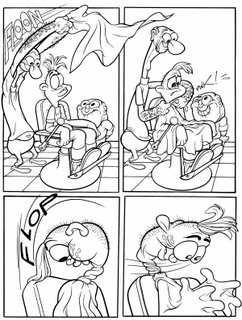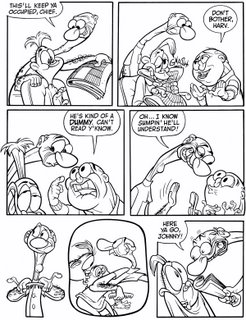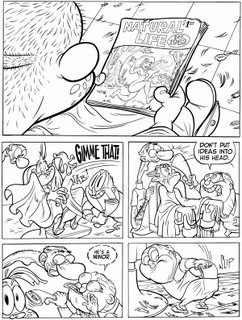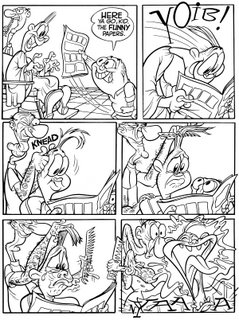I can only tell you what I know from my experience, and what I say is not meant to be the only way to do things. These are observations of what I like in cartoons, explanations of what I do and what I see in other artists' work that inspires me.
So I will risk some of these observations here.
Here's some more great art by Mike Fontanelli and inks by Shane Glines.
 These comics are an interesting blend of both comic techniques and animation techniques. In Spumco comic books, the story is broken down into smaller increments than a comic typically is in order to feature the acting and give the pages a sense of movement.
These comics are an interesting blend of both comic techniques and animation techniques. In Spumco comic books, the story is broken down into smaller increments than a comic typically is in order to feature the acting and give the pages a sense of movement.In The Barber Shop, I really wanted to give a feel of what it's like to be in an old fashioned barber shop.
Jimmy is there for the first time and is marvelling at all the particulars of the ritual-here he is getting draped by the protective hair repelling sheet.
OK-the art-the drawings are pretty solid which seems to be out of date these days-at least in animated cartoons.
You can really feel the grotesque exaggerations like Jimmy's eyes bugging out, because they are in the same perspective as the angle of his head.
Many cartoons today have arbitrary exaggerations, bug eyes and gross drawings just for the sake of weirdness. Here, every weird drawing tells the story. They are in context-funny and essential at the same time.
 Expressions and acting: This is where I think Spumco excells beyond what anyone else has ever done. Most cartoons, both past and present rely on stock acting. You can see the same 4 or 5 expressions and poses over and over again in most cartoons.
Expressions and acting: This is where I think Spumco excells beyond what anyone else has ever done. Most cartoons, both past and present rely on stock acting. You can see the same 4 or 5 expressions and poses over and over again in most cartoons.What we strive to do at Spumco is create a new and specific expression for every character and every moment in every story.
Each expression should describe a unique emotion and state of a certain character. I expect my artists to observe how people act in real life and not rely on generic expressions they have seen a million times in other cartoons.
This is an extremely hard habit to break, particularly because the networks and studios don't even grasp the concept of acting and use model sheets to stifle any possible urge to create something new. That doesn't mean that other cartoons don't have other good points so don't intrepret this as me saying that all other cartoons but Spumco's are crummy. I like lots of other cartoons way more than my own, but we are very good at acting.
 I'll leave this subject for now, and will come back to it later, but look at the expressions in each panel of these comics and see if you can describe them with a single adjective. Usually it will take a general adjective further mofified by 2 or 3 more and even then you can't get as specific as the drawing itself.
I'll leave this subject for now, and will come back to it later, but look at the expressions in each panel of these comics and see if you can describe them with a single adjective. Usually it will take a general adjective further mofified by 2 or 3 more and even then you can't get as specific as the drawing itself."A picture is worth a thousand words". If only that were true in modern cartoons. It should be.

Even at Spumco we don't always have an original specific expression for every drawing. The drawing of George in the 1st panel in the above page shows him with a one adjective emotion-"Happy". To me that means the drawing fails. Every single drawing should be original or I feel like I'm cheating the audience, because they have already seen "happy" before and deserve a new and more entertaining feeling.
As this comic progresses you will see the acting get more and more complex and specific and therefore entertaining. It was Mike's first comic and he got better and better as I kept beating these concepts into him.
Young cartoonists always ask me to teach them the Spumco "style". There is no Spumco style. Compare the George Liquor comics to the Heartaches cartoons. They are different styles but they use the same fundamental principles. I believe in strong fundamentals rather than superficial style. As I keep posting pages from these comics I will try to explain the principles behind them and will tell you about other artists past and present who are strong in these principles. It's a lot to absorb, so be patient!
Review of today's concepts:
Construction-solid drawings whose details wrap around the larger forms. Classic cartoons are very strong in construction-Chuck Jones, Clampett, Disney from the 1940s. Frank Frazetta is a master of solid construction. So is Jim Smith. Click the link to his site in my links section!
Exaggeration in context-Bob Clampett is the greatest at this.
Acting and specific rather than generic expressions- again Bob Clampett was the first to start experimenting with this concept. Falling Hair is a great example. So is The Great Piggy Bank Robbery.
Study the expressions and gestures of people you know. You will see tons of funny and interesting instances of emotions that have never been drawn before. Draw them!
Katie Rice is great at capturing specific expressions and poses of individual girls.
http://funnycute.blogspot.com/
Other sources to study for great acting are old live action movies and TV shows.
Kirk Douglas, Robert Ryan, The 3 Stooges, The Honeymooners are all worth studying.
Learn to caricature and then go to the next level by caricaturing not only a person's features, but his or her individual expressions and gestures too.

